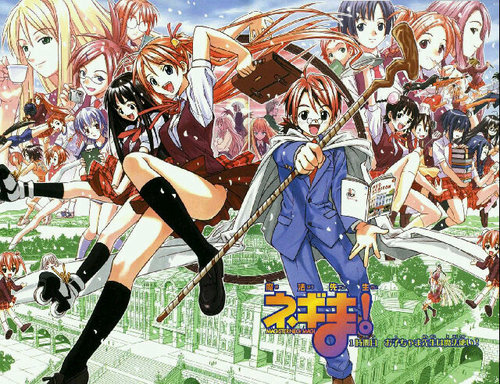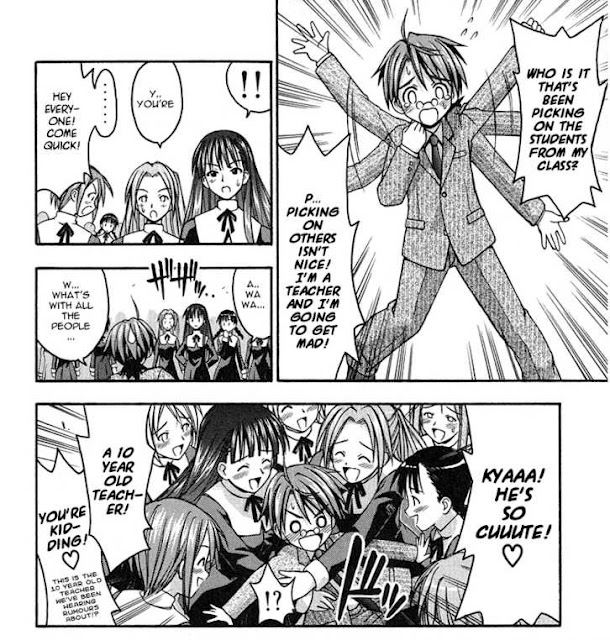Mahou Sensei Negima Review Part 1: There's No Way A Ten Year Old Can Be A Teacher!
Hi, guys! Welcome to the newest column on Jumping in Headfirst, where I discuss one of my favorite manga ever: Mahou Sensei Negima! Negima was created by mangaka Akamatsu Ken, most famously known for his work on the archetypal harem series, Love Hina. After Love Hina's massive popularity earned him a spot as one of the most famous mangaka of his era, he followed up with Negima. What initially looked like more a more fantastic version of Love Hina, the series gradually transitioned from a harem series into one of the best shonen manga I've ever read, complete with a massive, well developed cast, deep lore and amazing fight scenes. (Ones where "friendship" isn't the sole reason for every victory.)
Unfortunately, few people are aware of Negima's story improvements or genre change. Once a manga gets an anime the attention shifts entirely to the adaptation. It makes sense: the addition of voice, music, and motion create more immersive experiences. Even I'm no stranger to the idea of dropping a manga once an anime to a series proves itself to be a proper adaptation.
But in Negima's case, this was more of a drawback--adapted long before it ever got off the ground as a proper shonen series, the anime gained notoriety for its early wacky scenarios and goofball characters. So much so, it garnered an unrelated spin-off anime, a manga based on said spin-off, and even a japanese drama. What I'm saying is: the true story got utterly buried, and this is my attempt to unbury it. Over the next few weeks and months, I'll be trying to cover the original Negi series as much as possible--sometimes chapter by chapter but mostly in massive chunks in order to catch up to it's equally cool sequel manga, UQ Holder. For now, I'll be going volume by volume, so let's lead things off with the first six chapters.
When our story starts, our unassuming main character, Negi Springfield, is just graduating from some sort of...wizard school in England. They don't focus on what the school is, and as you follow the manga you get the hint that it's kinda like passing a driver's license test--sure you can legally drive, but that doesn't mean it's safe for you to be out on the roads. Over the next few volumes, we find out Negi's a competent spellcaster, but also that he's at the very bottom of a very large mountain that he's eventually going to have to reach the top of. Still, his graduation is provisionary--though he aced being a mage with flying colors at the tender age of nine (!), he's got one final assignment: to become an English teacher in Japan! It's an assignment that takes not only Negi, but his fellow graduates off-guard. After all, a ten year old can TOTALLY become a magician, but a teacher? That's absurd, right?
See, even his friends agree....though perhaps a bit strongly. Nevertheless, he's assigned to be a teacher at Mahora Academy and heads on his merry way to start his newest adventure. Again, the early parts of Negima consists of fairly pat harem work--plenty of misunderstandings that lead to ecchi situations, with occasional sections of well-done character development that would be endearing if you weren't aware that it was all to make you favor one girl over another as your waifu.
In Negima's case, the first main characters we find ourselves introduced to are Asuna and Konoka. Asuna's our secondary protagonist behind Negi--she's loud, brash, and not too bright--but she's also caring, brave, and honest to a fault while being an excellent athlete. Konoka's more of a mystery--she's a laidback sort with a unique sense of humor, and basically the perfect foil to her roommate Asuna. The two of them are introduced rushing to class, because no one's ever on time for school in anime. In all fairness, junior high and high school are when school really started to suck (they took away recess!), so it actually kind of makes sense. In any case, they're the first students on Mahora Academy's campus that Negi comes into contact with, as Asuna discusses the crush she has on her teacher Takahata, and Negi interjects to explain her chances with him.
Unfortunately, this doesn't exactly ingratiate him to her--even though Konoka certainly likes him well enough!
Of course, when there's this much "chemistry", you can see where this is going. Negi not only introduces himself as their class's new English teacher, but after a conversation with the principal (also Konoka's grandfather) gets told he'll be living with Asuna and Konoka. So now that we've set up one of the most awkward living situations ever, he gets to meet his class! There's a scene of him first walking in the door that shows the girls, but I like this better as an introduction.
Though it's less visually interesting, it shows off Akamatsu's ability to plan ahead. An introductory cast of 31 characters (plus the teacher for 32) is immense. Most series have to expand far outward before they ever introduce this many people...and most writers don't have anything resembling a plan. There's countless stories of mangaka basically just creating characters to fill space and figuring out what to do with them later. (Hi Tite Kubo!) But if you pay attention here, Ken's already got the backstory for most of the characters who will go on to have major arcs in this series. I won't spoil them for now, but come back to this page later to see just how many of these "little facts" become important.
Anyway, the introduction to the rest of the class goes fairly well, with most of the girls in the class fawning over how adorable he is. Which, let's be honest here...
He totally is adorable. Honestly, Akamatsu Ken is and was light years ahead of the game. End-series and adult mode notwithstanding, Negi doesn't often look or act like your typical shonen character. He's small, unassuming, and not really overtly masculine despite kicking ridiculous amounts of ass. But it's never a solo effort--Negi grows into a bad-ass, but he's never a Goku or an Ichigo that does so much of the work you wonder why other characters even exist around him. He needs the help of his students, some of whom go from stereotypical slice-of-life anime girls to believably capable bad-ass survivors with lightning speed.
And not all of them become fighters either, because not all strength has to be (or should be) measured in how well you can cave someone's face in with your fist. They become skyship pilots, treasure hunters, or even just the support Negi needs when the weight of the worlds becomes too much to bear on his own. If you're looking for cool female characters, Negima has them in spades...though at this point in the series, they're kinda trapped in tropeland. So we'll have to give it a bit of time.
After the first chapter that sees Negi get introduced to his class and learn to make friends with Asuna (who looks so much like his sister Nekane he often ends up crawling into bed with her...don't ask), the next few are stand alone stories featuring things like:
- Negi creating a love potion to help Asuna get the teacher she has a crush on to reciprocate because that's totally not illegal, only for her to force him to drink for hilariously inappropriate results. This helps kickstart one of the minor subplots of the series (that most of the entire class eventually falls in love with him), and helps drive home the point that Ayaka, their class president, is a massive shotacon. Because she absolutely did not need the potion to basically propose to him like that.
- The requisite bathhouse chapter. In addition to having a boob size contest (because why wouldn't you), this chapter gives a bit of exposition on Asuna's background--her parents died not long after she was born, and so she's been under the care of Konoka's grandfather since then. This is totally not a pivotal plot point that will become all too relevant when the series starts to get more story-focused.
- A dodgeball showdown with some older girls from high school. This is basically the capstone for Negi's "shaky" days as a teacher, with him stepping up to defend his students from bullying...then coming up with a non-violent way for class 3-A to settle their differences with the senior girls, and finally defending them when the seniors can't accept their losses gracefully.
For what it's worth, none of this is actually "bad". Ken does the best he can to make all of this entertaining, but if you've got a lot of anime/manga experience under your belt it can seem kind of rote. But that's okay--at the time Akamatsu was trying to convince his editors to allow him to create a shonen series, and had to do his best to convince all involved that it was actually a harem. But with the premiere of volume two, that would start to change...slowly.










Comments
Post a Comment